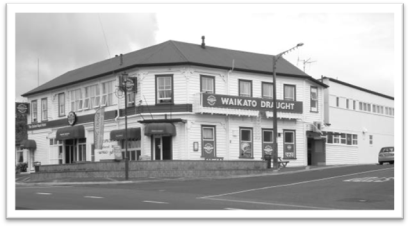HH-41: Tirau Hotel (Oxford Royal Hotel)

Date of Photograph: 04/09/2008
Location and Zoning Information | |
Address |
SH1 and Hillcrest Street |
Current Owner |
Arthur Anae & Leslie Divers |
Legal Description |
Lot 1 DPS 88273 |
Zoning |
Town Centre Zone |
Valuation Number |
0541509500 |
Google Maps Link |
|
Architecture | |
Date of Construction |
1877-81, Completely re-built 1907. |
Materials |
The main (original) part of the hotel still features original building fabric and elements like windows and balcony brackets. |
Architecture/Engineer/Builder |
The architectural integrity of the hotel is mixed, but it still reads as a historic hotel and is used for its original function. The hotel has had many changes over the year, verandahs filled in, new entries added, additions to the sides and rear. |
Condition |
|
Original Site Recommendation |
|
Current Use |
|
Statement of Significance |
Criteria for Scheduling: 1, 3, 6, And 7 1. Aspect of history - associated with settlement of Tirau (Oxford) 3. Community association – associated with the growth of Tirau (Oxford) as a stage stop and small town. 6. Educational Use – could be included as an item on a heritage trail, 7. Archaeology - pre 1900 the site is protected under the Heritage New Zealand Pouhere Taonga Act 2014; has the potential through archaeological investigation to provide information about New Zealand and the South Waikato District’s history. 10. Architecture (This needs to be added so the historic parts of the building can be preserved). The building has mixed architectural integrity due to the number of changes and additions but still retains some original fabric like the double hung sash windows, hipped roof, balcony brackets, cladding, etc.) District Plan RulesDemolition – DIS. Protection focus - 1, 3, 6, 7, and 10. Mitigate the effects of demolition by requiring the applicant to provide a Historical Building Documentation (HBD) which should include: the structure’s history, photographic documentation, and measurements of the item prior to removal. Demolition of additions is encouraged. Alterations necessary for the primary purpose of improving structural performance, fire safety or physical access – CON -Refer to HH-R2. Other Additions/Alterations - DIS. Refer to HH-R3. Protection focus - 1, 3, and 10. Effects can be mitigated/ remedied through: a) HBD (see mitigating the effects of demolition). b) Design Rules: The overall visual character/ shape of the historic building should be identifiable. The addition should not dominate the existing building frontage on the corner of SH1 and Hillcrest Street. New work should be restricted to the rear of the building or existing additions. Special elements that are associated with the pre-1900 part of the structure’s architecture should be retained:
c) Building Materials Rule: If repair of the buildings is proposed the materials used for the exterior walls and elements, in the pre-1900 part of the structure, should be similar in type, dimensions and profile as the existing exterior fabric of the building. Repair of the Structure –PER. Refer to HH-R1. Protection focus - 1, 3, and 10. a) Building Materials Rule: If repair of the buildings is proposed the materials used for the exterior walls and elements should be similar in type, dimensions and profile as the existing exterior fabric of the building. b) Design Rule: Repair or replication work should match the existing design, profile, and materials (i.e. wood) of the building’s historic elements unless the repair is to a more recent addition. Reuse/ Change of Use – PER. Refer to HH-R1. Protection focus 1 and 10. This is generally allowed and supported. Rationale for supporting reuse- History is an ongoing process. Reuse of historic structures in most instances ensures the structure is retained for future generations. Advice or Community concerns will be considered as well as economic viability, Occupational Safety and Health, zoning, etc. Disturbance of the site surface/earthworks – PER. Refer to HH-R1.Protection focus – 7. Existing plan rule relating to archaeological sites. This is a pre-1900 structure and there is a potential that archaeological deposits could be found if earthworks are carried out under or adjacent to the hotel. Internal Changes – PER. Refer to HH-R1. Protection focus 1 and 10. Design Rule: Significant historic interior spaces and use areas should be identifiable. Remodelling of rooms, hallways, and facilities (kitchens, etc) is allowed but alterations must be documented (HBD). Relocation – DIS. Refer to HH-R3. Protection focus – 1 and 3. Relocation may be necessary to preserve an item for future generations. Mitigate the effects by 1) Consulting with the local community and/ or consulting with Iwi or special interest groups, 2) Relocating to a similar setting, 3) Documenting (HBD), 4) Applying rules relating to archaeological sites. |
History |
|